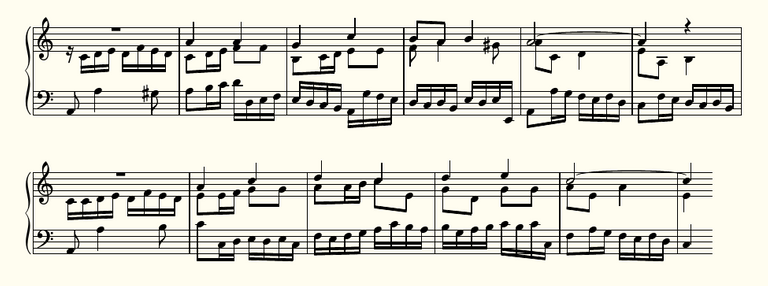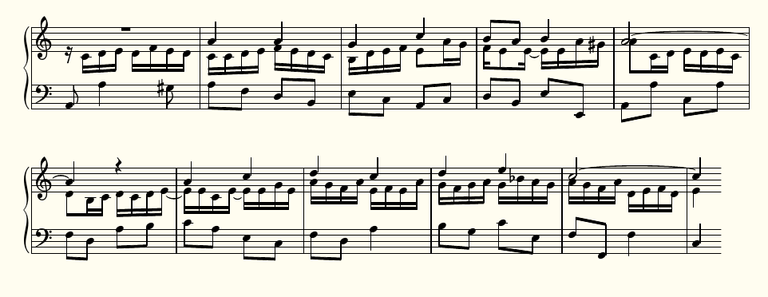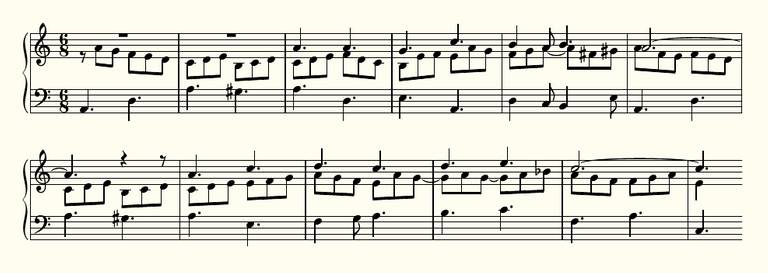How to compose a choral prelude (2)
Last Sunday I wrote the first part in a short series of posts about my attempts to create a choral prelude (https://steempeak.com/classical-music/@partitura/how-to-compose-a-choral-prelude-1). With Johann Gottfried Walther's choral prelude to the first verse of "Nun komm der Heiden Heiland" as a model I formulated at a simple procedure to create a similar composition and applied it to the first phrase of the same choral melody. The procedure in short is:
- take an existing choral prelude with the choral melody in the soprano voice
- identify the main harmonic notes in the bass voice
- decide where you want the main 'mobile' role to be, in the tenor voice or the bass voice (or a combination)
- write an introductory phrase to establish the tonal key.
- write the parts, making sure the bass voice hits the main harmonic notes at the right time.
With this procedure I was able to create three different pieces based on the first phrase of "Nun komm derHeiden Heiland". The writing in a post like this is of course always a summary of the actual process. And the actual process is not as clean as you might think when reading this or the previous post. It takes me a lot of sketching, errasing and sighing to arrive at the results shown. To give an idea I made a pictures of some of my sketches.

Now I'll continue with the second phrase of the choral melody. As in the first post I am going through the proces in a step by step manner to extend two of the pieces I created in the first post. As a wrap up I'll apply all steps in one go to the third piece.
In the next fragment the second phrase of the choral melody in Walthers prelude is shown, with the melody notes circled in green, and the main harmonic notes circled in red.

Omitting all notes, except the circled ones, gives:

The f sharp in Walther's original work nicely. In my own versions however I had trouble to make it work. Walther has the choral melody in half tempo and has therefore more time to make the transition to A through G. I can do the same of course, but the results did not satisfy me. In the sketches above you can see some of my attempts. In the end I decided to skip the alteration and make it an f instead. The harmonic outline I used is therefore:

Before I start writing the actual parts, there is another thing to note in Walther's example. Between the first and second phrase he writes a short fragment of intermediairy music to transition from the first phrase to the second. It sort of emulates the time you would take to breathe if you were to sing this choral. So, before I can continue with the next phrase of the choral melody, I first have to write some sort of transitional phrase. Walther uses the next phrase of the choral melody to create his transitional phrase, in a process called fore-imitation (see bars 6 and 7 in Walther's music). As I did not use that technique to create my introductory phrase, it would seem strange to use that technique now as transitional phrase. A way to create unity throughout the piece is to incorporate the main idea of the introductory phrase into the transitional phrase. As there are two more transitionale phrases to write, it is also a good idea to create something that can flexibly used in the other two transitinal phrases as well. Ideally all transitional phrases are similar though not exactly the same. That creates unity throughout the piece as well.
For the version with the bass voice as main 'mobile' part, I came up with:

The last notes of the first phrase of the choral melody are shown and a three bar transition phrase. The last a of the choral melody is extended into the second bar of the transition phrase, thus creating overlap betwee the elemants of the piece.
For the version with the tenor voice as main 'mobile' part, I settled for a transition phrase of only two bars.

Now it's time to start writing parts for the second phrase of the choral melody. First I'm going to create a part for the bass voice of the piece with the bass voice as main 'mobile' part. After several attempts, I came up with:

The tenor voice is now sort of a fill-in exercise. The soprano voice is given (choral melody) and the bass voice is already written. The tenor voice has to fill in the gaps, and possibly complete harmonic chords on the stressed parts of a bar. I am going to do just that. The tenor voice is written functionally, and not very creatively. The result:

The work for the version with the tenor part as main 'mobile' part, the work is a bit more complicated. The main bass notes are known as is the choral melody. The goal is to create the impression as if it is freely written. In reality it is written from main bass note to main bass note. It has to fit harmonically after all. Yet I did change one bass note. In the second bar the bass voice plays f - d -a instead of f -g -a. The g in the bass meant that the tenor had to play b, and that just did not fit. With d in the bass the tenof could play f and that fits better in the music. The result:

The result of today's work is 8 extra bars for two of the pieces I created last Sunday. Glueing introductory phrase, first phrase of choral melody, transitional phrase and the second phrase of the choral melody together, both pieces look like this now:


At the end of this post I included recordings of these fragments to give an idea of how they sound.
Taking into account the idea of the transitional phrase, my procedure for writing a choral prelude becomes:
- take an existing choral prelude with the choral melody in the soprano voice
- identify the main harmonic notes in the bass voice
- decide where you want the main 'mobile' role to be, in the tenor voice or the bass voice (or a combination)
- write an introductory phrase to establish the tonal key.
- write the parts, making sure the bass voice hits the main harmonic notes at the right time.
- create a transitional phrase, flexible enough to be used several times; possibilites are to use fore-imitation, or to use elements from the introductory phrase
And applied to my third piece the reult is (note that the transitional phrase is almost identical to the introductory phrase):

In the next part I'll treat the last two phrases of the choral melody. And hopefully I will have three completed pieces of music!
You can support me using Steem Basic Income

I would like to be able to listen to this but I have no idea how to read music. Is there any way for you to add like a sound or something so ignorants like me can listen to it?
Yes, I understand that not every one can read music. My idea was to perform and record them once they are finished.
Having recordings of the intermediate results can be of additional value. My first priority is to finish the writing. If I have time left I'll add recordings of the fragments as they are now.
Posted using Partiko Android
I can read music, so I can "hear" the intermediate results you have posted here. :-) That being said, I think it would be very nice for those who can't, to be able to listen to the process.
Thanks for the post, very interesting read, please keep up the good work!
Ooohhh, I see!!! Very good idea yes. Looking forward to that!!! Following you so I won't miss it ;)
I added sound recordings of the three fragments. The embedded player if SoundCloud is rather ulgy so I embedded the recordings at hte end of the post.
Thank you so much!!! Beautiful sound, exactly what I thought it would be :)
Resteemed, your post will appear in the next curation with a SBD share for you!
Your post has been supported and upvoted from the Classical Music community on Steemit as it appears to be of interest to our community. We also support jazz and folk music posts!
If you enjoy our support of the #classical-music community, please consider a small upvote to help grow the support account!
You can find details about us below.
The classical music community at #classical-music and Discord. Follow our community accounts @classical-music and @classical-radio or follow our curation trail (classical-radio) at SteemAuto!
Delegation links: 10SP, 25SP, 50SP, 75SP, 100SP, 150SP, 200SP, 250SP, 500SP, 1000SP